Catio decorating ideas you and your cat will love
Welcome to my blog post, where I’m thrilled to share the newest addition to my home that’s sure to make any cat or cat lover purr with delight – my brand-new cedar catio! As a dedicated pet parent, I’ve always strived to create a safe and enriching environment for my furry friends, and this outdoor catio is the perfect example of that commitment. My cats have really enjoyed their PVC catio built outside my living room window for years, But I wanted to give them a more upgraded, permanent catio with all the added bells and whistles.
A PVC catio is still an amazing affordable solution for those who cannot make a permanent catio because of their living arrangements or for those who want to be able to move the catio easily.

You might like this…
Want to learn how to make a PVC Catio? It’s easy! Read my blog post “How to build a PVC catio” for a step-by-step guide!
And for those who may be wondering what a catio is, it’s essentially a cat patio or an outdoor enclosure that provides a safe and secure space for indoor cats to experience the outside world without the risks associated with roaming freely. It’s a fantastic way to enrich your cat’s life, offering them fresh air, sunshine, and the sights and sounds of nature, all while being great cat parents by keeping them safe from potential dangers like predators and traffic.
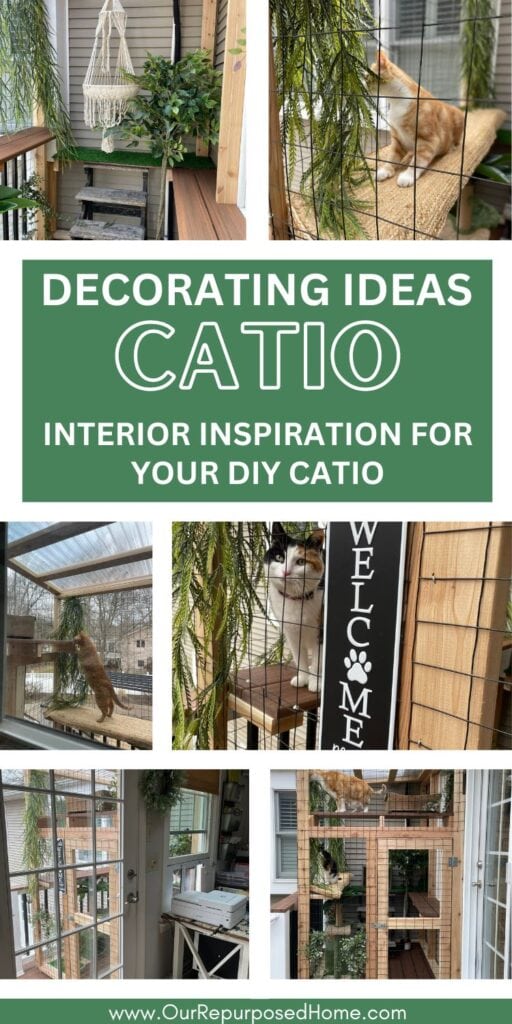
In this blog post, I’ll take you through the journey of designing, building, and decorating my catio, sharing all the tips, tricks, and catio ideas I’ve encountered along the way. From cat-friendly accessories to safety measures and personal touches, I’ll cover everything you need to know to create a safe space you and your feline friend will love.
So, whether you’re thinking about building a catio of your own or simply looking for some inspiration to enhance your existing outdoor cat space, I invite you to join me on this exciting catio adventure. Let’s dive in!
This post may contain affiliate links. If you choose to purchase a recommended product, I may receive a small commission at no additional cost to you. Rest assured that I will not recommend any product that I would not use myself. For our full policies and disclosures click here.

You might like this…
Want all my cat projects in one place? Check out my new post “The best DIY cat projects and ideas for your home“
Catio design ideas
Because this post focuses on the interior of the catio, I am not going to go into too much detail of the construction of the catio itself. But I will give you the basic information so you can design and build your own.
The first and most important step in creating your catio is to measure how much outdoor space you have for your catio plan. Take note of the width, length, and height to determine the size catio you wish to build. Keep in mind that cats love to climb. So height is more important than the width and length of the catio. Build it tall enough to add multiple levels of shelves or perches for them to climb up on.
You will also want to determine if you want or need, to build a floor for your catio. If your catio is going on your deck or patio then you probably don’t need a floor. If you want to give your cats some fresh lawn to crawl on, then you do not need a floor. But if it is going somewhere the cats can dig, or something can dig into it, or they could get into something they shouldn’t, then you might want to consider adding a floor to your design.
What are you going to make your catio out of? There are many options available such as PVC pipes and flexible fencing, 2×4 wood construction with pet screen or wire fencing, even metal dog cages or chain link fencing make great catios. All of these will require different ways to finish the interior.
Once you determine your catio size, you can get pen-to-paper to decide what shelves or perches you want in the space. Consider the height and width of the shelves, and the placement around the catio, to ensure you have enough support for them. Determine how the cats will access one area from another and make sure they can reach them with ease.

Also, decide on the type of roof you will need. Have snow? You may want to build a stronger roof structure to hold heavy snow loads. If not, then you may be able to just use fencing on the top to keep the cats in. Also, think about shade. Do you need some kind of coverage to keep the cats out of the hot sun?
When I built my PVC catio we needed to remove the clear plastic roof in the winter to prevent the whole thing from collapsing which meant the catio was closed in the winter. The cats would be mad at me for weeks when I closed it. But this time we have a 2×4 construction for both the sides and the roof so they can access the catio even in the winter!
And don’t forget, how will your cats access this catio? A window catio style? A cat door? Thru cat tunnels? Will it be a balcony catio, or maybe a cat patio? Whatever you decide your new catio will be, keep all these design points in mind during your design and construction phase.
What to put in a catio
Being an interior decorator, my favorite part of any DIY project is making it look good. With the PVC catio I previously built, it wasn’t pretty, but it did the job. But, now with this cedar wood catio, it’s so pretty! Happy dance!
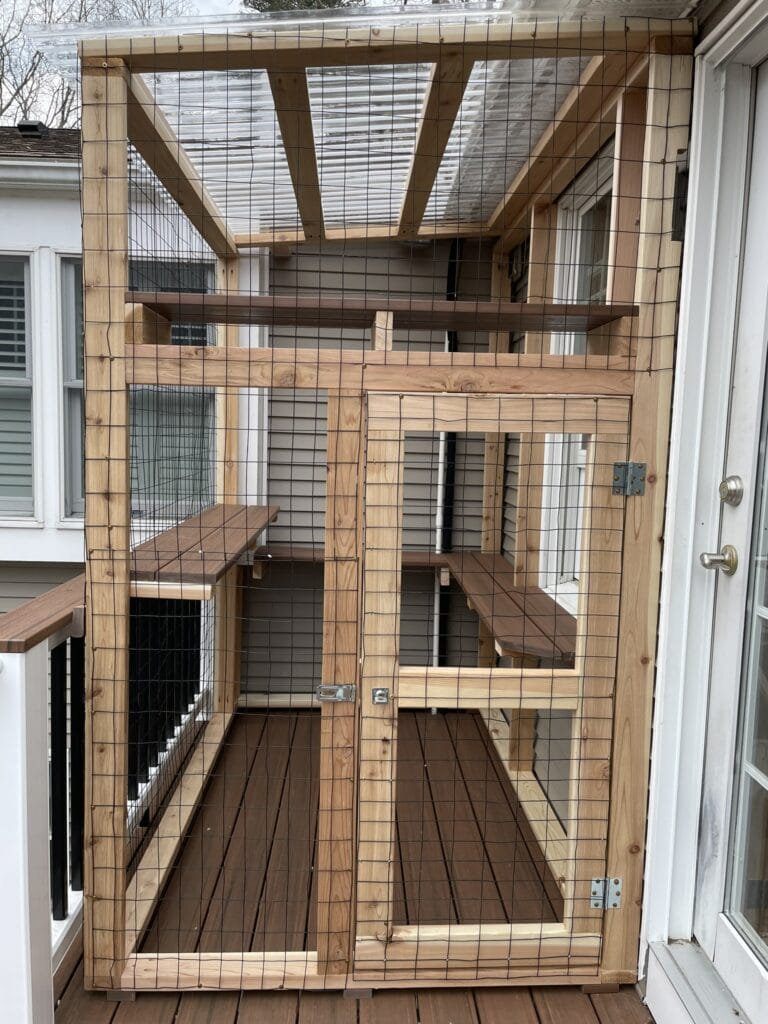
We decided to build the catio out of cedar because of its long-lasting wear, bug repellency, and good looks. I repurposed our black metal garden fencing from the PVC catio so I didn’t have to purchase new fencing. We also made the shelves out of left-over Trex decking from our deck upgrade. So not only is the cedar catio long-lasting but the shelves will last even longer! The supports for the shelves were made from scrap cedar boards from the building. So we managed to use a lot of existing materials for this catio and saved a lot of money. Research what type of material is good for your unique situation and preferences.
As far as decorating, once you have your basic design and build, you can have so much fun making this catio your own style. I decided to go with a boho/gardening theme for my catio. Fake hanging vines and a rectangle basket I already had inspired me. From there I added items to complete the look.
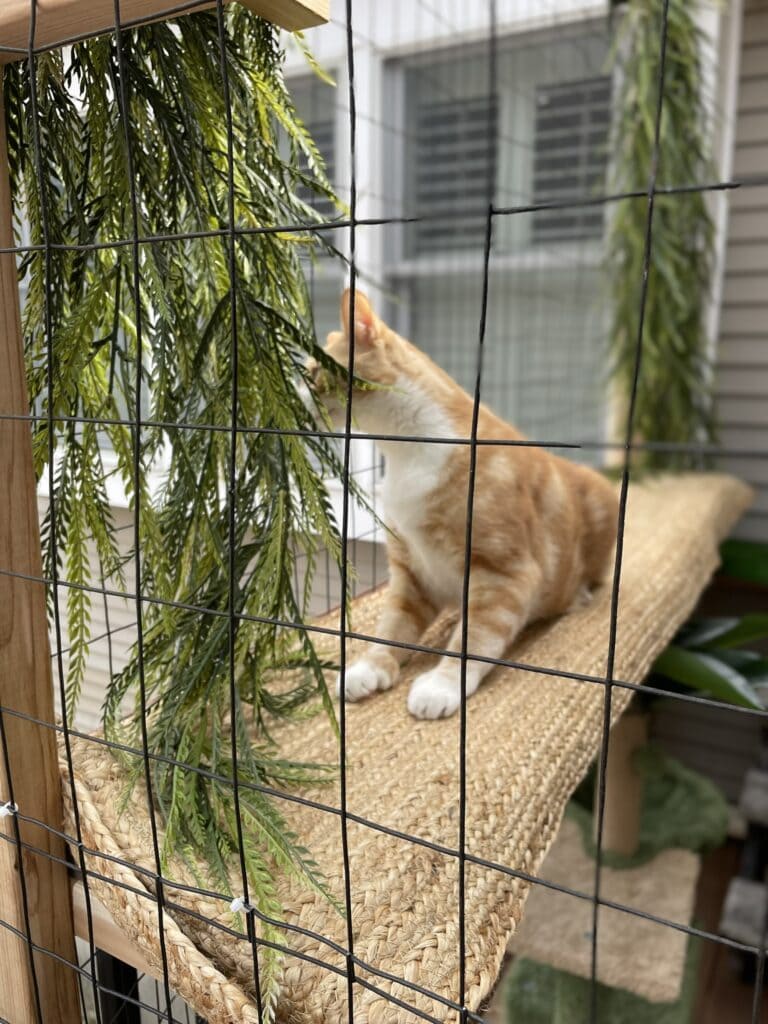
I purchased a braided table runner to use on top of one of the shelves and a faux grass runner for another to soften all the hard surfaces. I plan on purchasing these tablecloth brackets to hold them in place.
I purchased an outdoor rug for the floor to give the cats something soft on their feet. And an inexpensive faux tree from Hobby Lobby to put in the corner to give them something to hide behind when on the shelf.
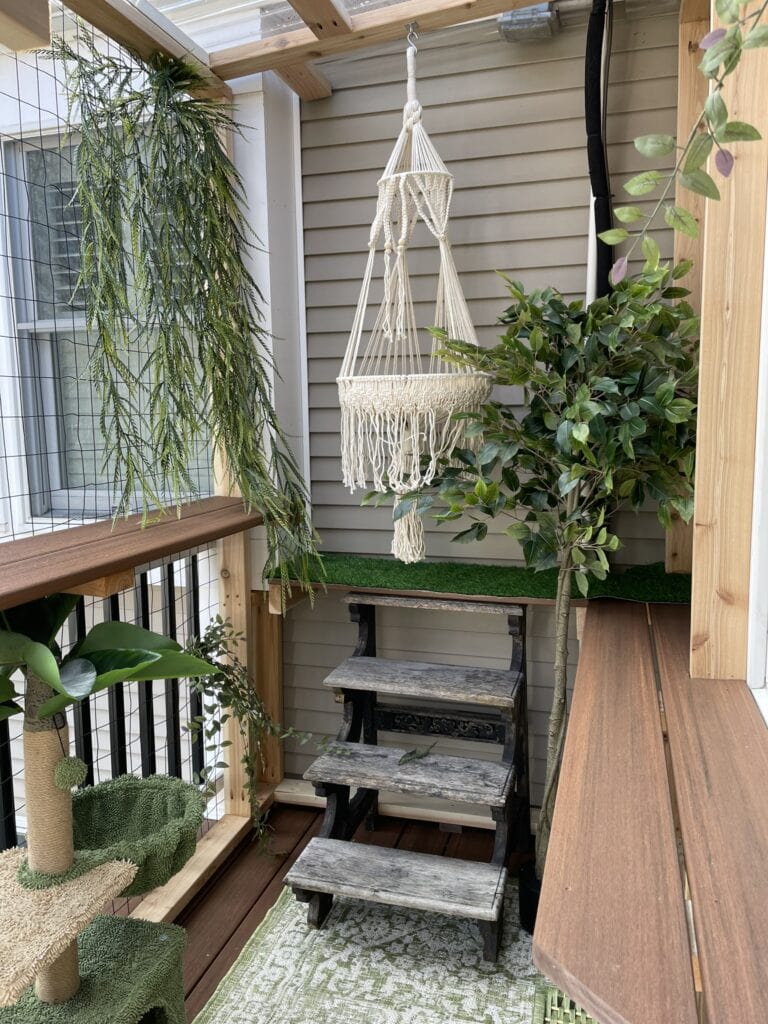
My old wood plant stand makes a cute set of stairs from the floor to the first shelf. I haven’t decided if I am going to refinish it or not. I kind of like the rustic look of it and it’s under a roof so it shouldn’t get too wet.
I had an existing cat tree that they didn’t really use inside so I put that in there too. It added some more texture and interest to the catio as well as giving them something else to climb and scratch.
I also purchased a hanging macrame cat bed. It’s so cute! Very Boho! I attached this bed to the roof rafter and it’s so pretty.
I plan on researching some PVC retractable screens that we could use on rainy days which we would only need during heavy, driving rains. I’ll let you know if I find something.
When it gets warmer I will purchase some hanging plants as well.
Here are some other catio decorating ideas for your custom catio.
- Cat-friendly plants including cat grass are a must for your catio. Here is a link to a list of cat-safe plants as well as plants that are toxic to cats.
- Water fountain or other water element. Whether for drinking or just playing, adding a water element will thrill your cats.
- Include different levels and climbing areas for your cats to explore. The higher the better. The more interesting places for them to explore the better.
- A cat tree is a great way to add a climbing element to your catio, especially if you don’t want permanent structures.
- A cat bed is a great idea to give your cat a place to curl up in the sun for a nice nap.
- Bird feeders would be an exciting addition for your cats by attracting birds (or squirrels) LOL to watch from the catio.
- A cat house or even a box for your cats to hide or nap in would be fun.
- An outdoor litter box would be necessary if your cat doesn’t have access to the house.
- Rugs or mats will add personality and comfort for your cats. Don’t forget to use an outdoor rug and don’t leave a wet rug on your wood deck. Been there, done that!
- Ramps or stairs are a safe way for your cats to get from one area to another especially for older cats or kittens. You can build your own or purchase ready-made ones.
- Cat bridges are really cool. I might make one with the leftover wood from the build. I’ll let you know if I do.
- Cats love tunnels. You could purchase a tunnel or DIY one out of cement tubes or plastic drainage pipes.
- Scratching posts are important if you don’t want your cats scratching your furniture or something else in the catio.
- Add a chair or lounger if you have plenty of space so you can enjoy the catio with your furry friend.
Safety measures – ensuring your cats well being
When it comes to designing, building, and decorating a catio, ensuring the safety and well-being of your feline friends should be a top priority. Here are some essential safety measures to keep in mind:
Secure Enclosure: The catio should be securely enclosed to prevent cats from escaping and to keep unwanted visitors, such as predators, out. Use sturdy materials for the walls that are strong enough to withstand scratching and climbing.
Escape Routes: While the catio should be secure, it’s also important to provide an easy way for cats to exit in case of emergency. Consider installing a cat door or leaving a window open as an escape route.
Toxic Plants: Be mindful of the plants you place in and around the catio. Some plants can be toxic to cats if ingested, so it’s best to choose cat-safe plants such as catnip, cat grass, and spider plants.
Sharp Edges: Ensure that there are no sharp edges or corners in the catio that could potentially harm your cats. Cover any exposed edges with protective material.
Supervision: While the catio is a safe space for your cats to enjoy, it’s always a good idea to supervise them, especially if they are young or have mobility issues. This way, you can quickly intervene if they get into any trouble.
By implementing these safety measures, you can create a catio that not only provides your cats with a safe and stimulating outdoor experience but also gives you peace of mind knowing that they are well-protected.
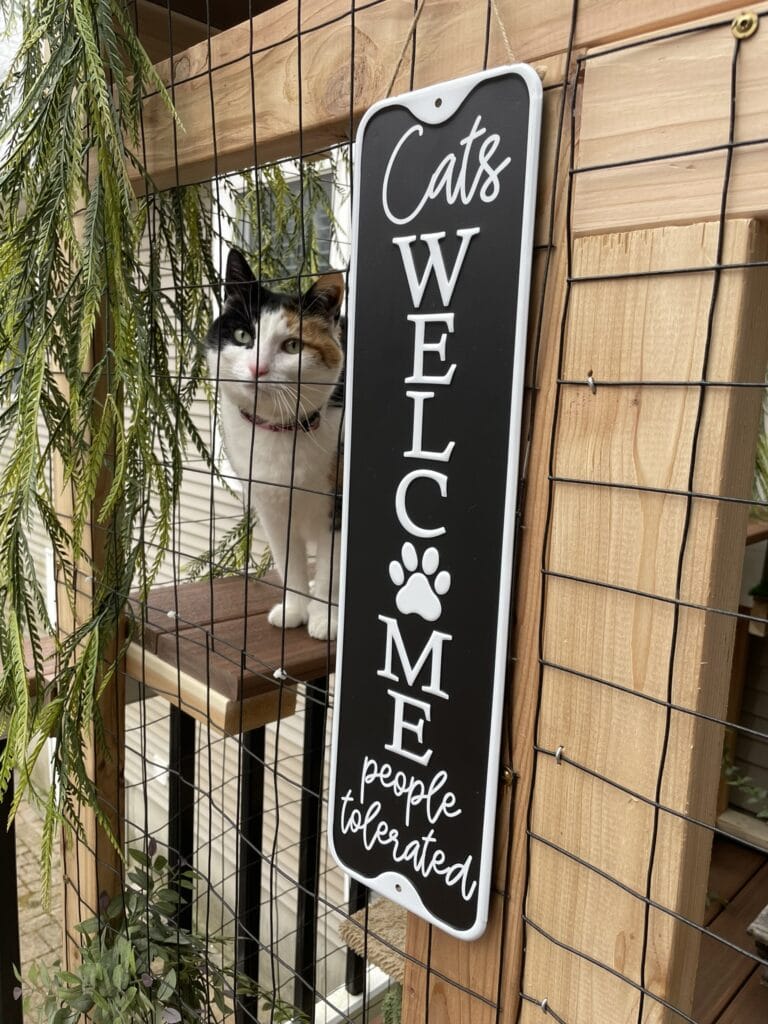
Building catios has been a rewarding experience that has not only enriched the lives of my cats but also added a unique and enjoyable element to my home. From the initial design and construction to the final decorating touches, every step has been filled with creativity and joy.
I encourage all cat lovers to consider building a catio for their furry friends. Not only does it provide a safe and stimulating outdoor experience for indoor cats, but it also offers peace of mind for pet owners knowing their cats are happy, healthy, and secure.
So, whether you have a spacious backyard or a cozy balcony, there are endless possibilities for creating a catio that suits your space and your cat’s needs. Get creative, have fun, and give your feline friend the gift of the great outdoors with a catio of their own!
I’d love to see your creativity in action! Share photos of your own catios in the comments below. Let’s inspire each other to create the ultimate outdoor space for our feline friends!
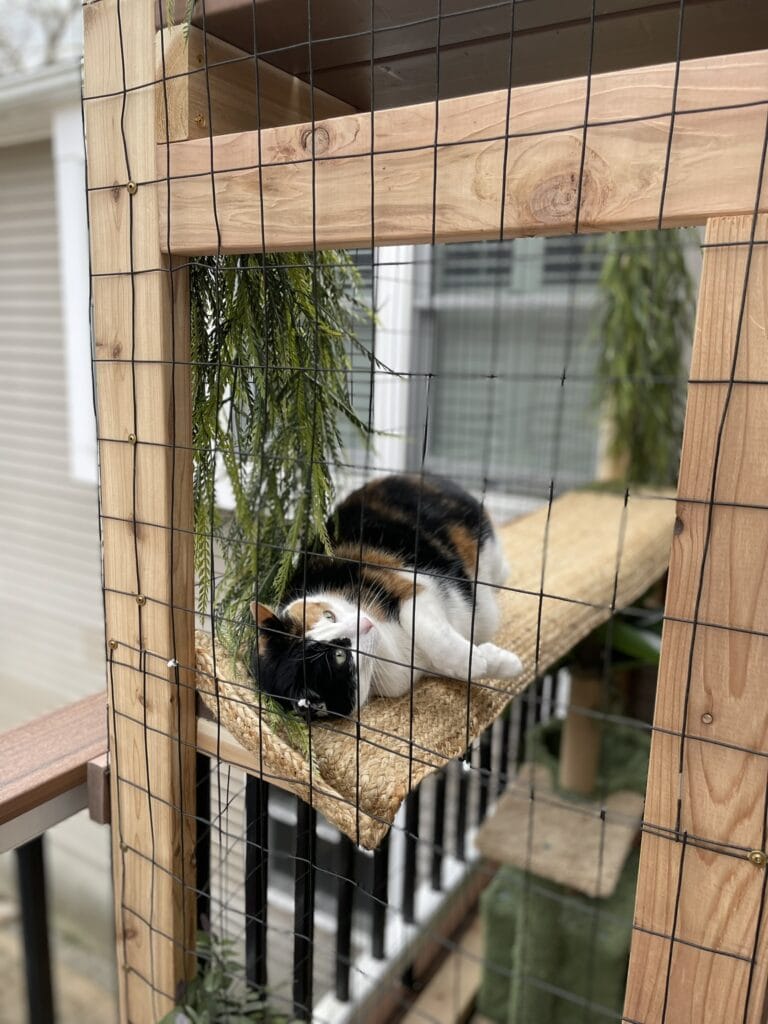
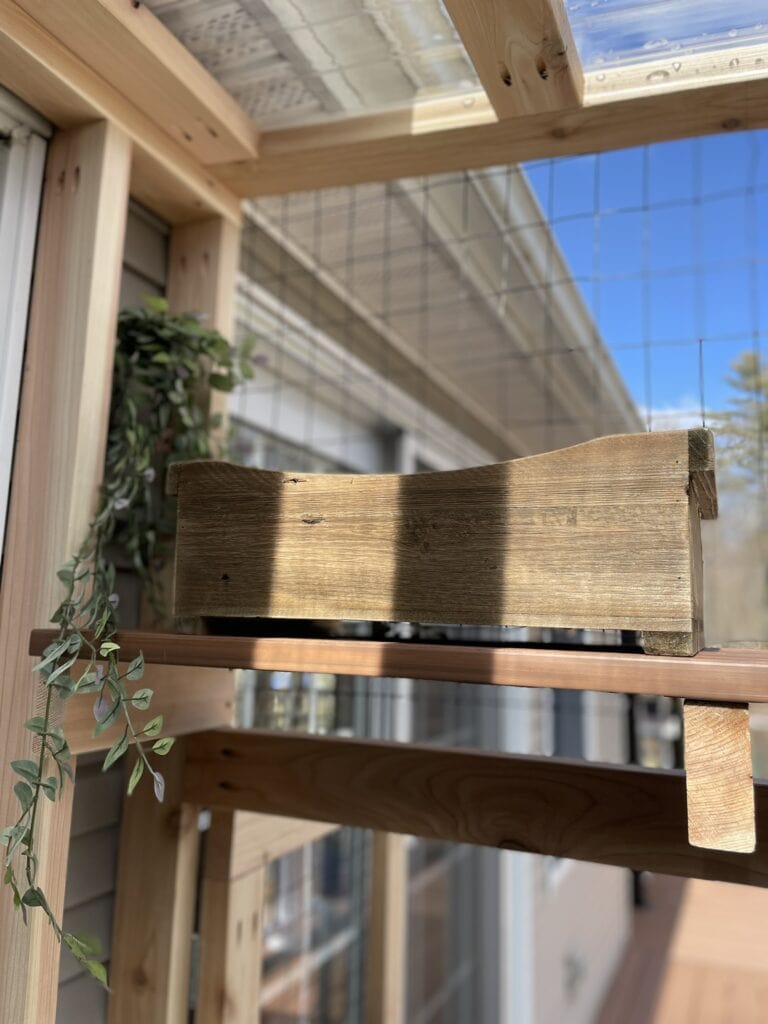
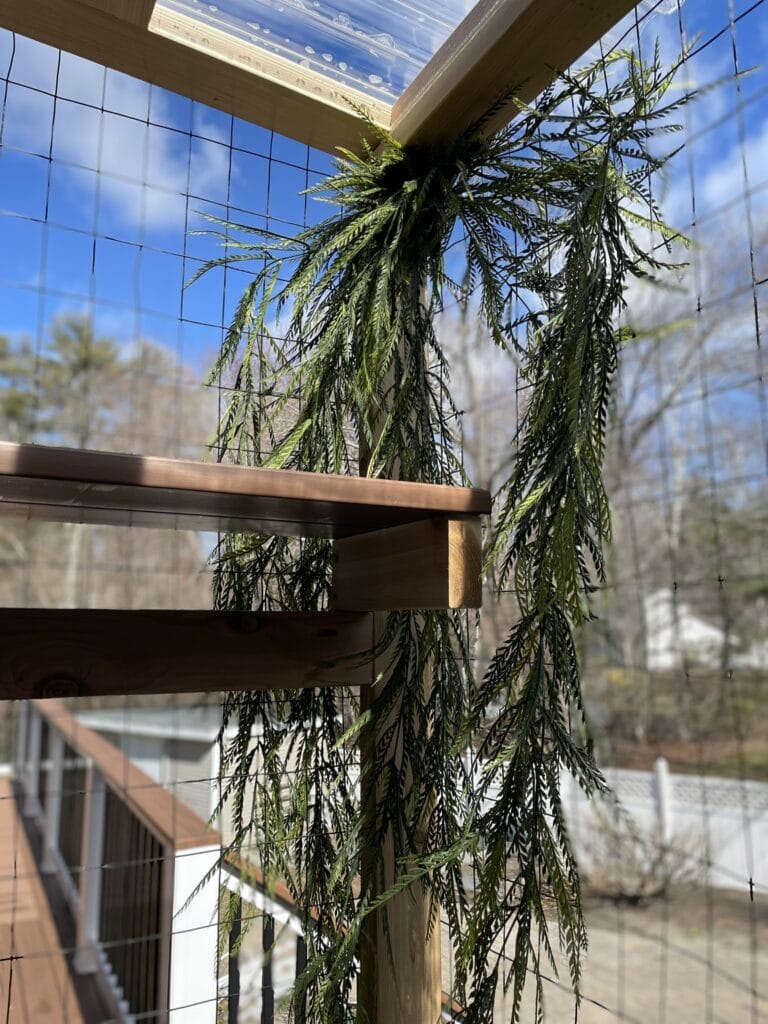

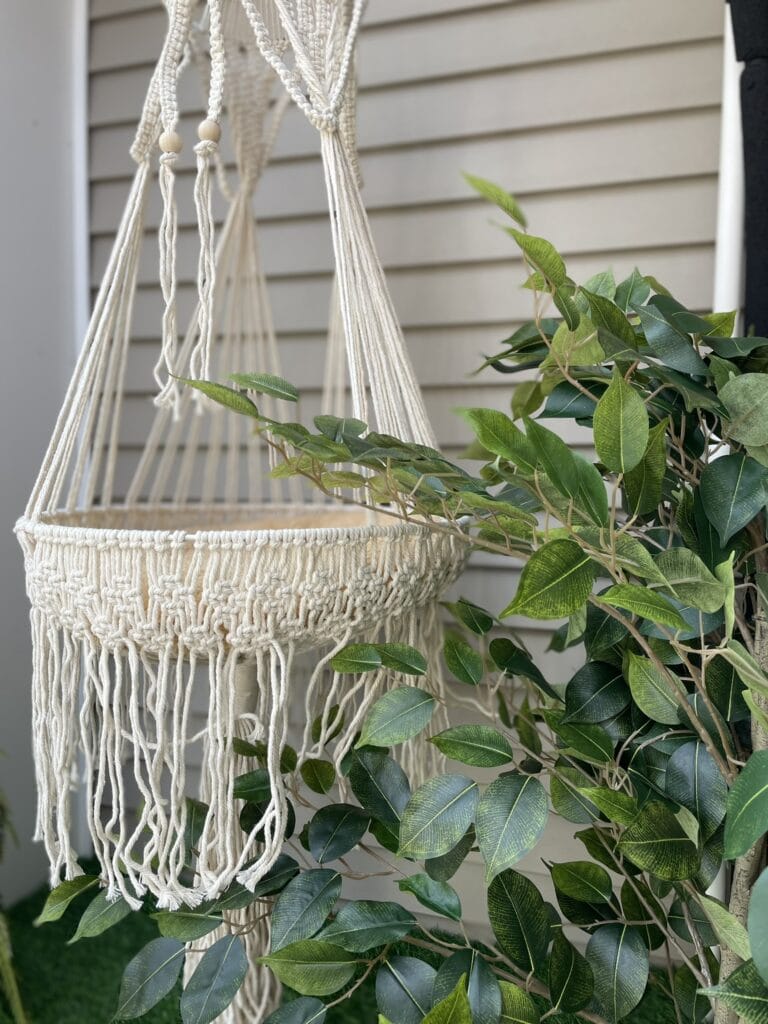
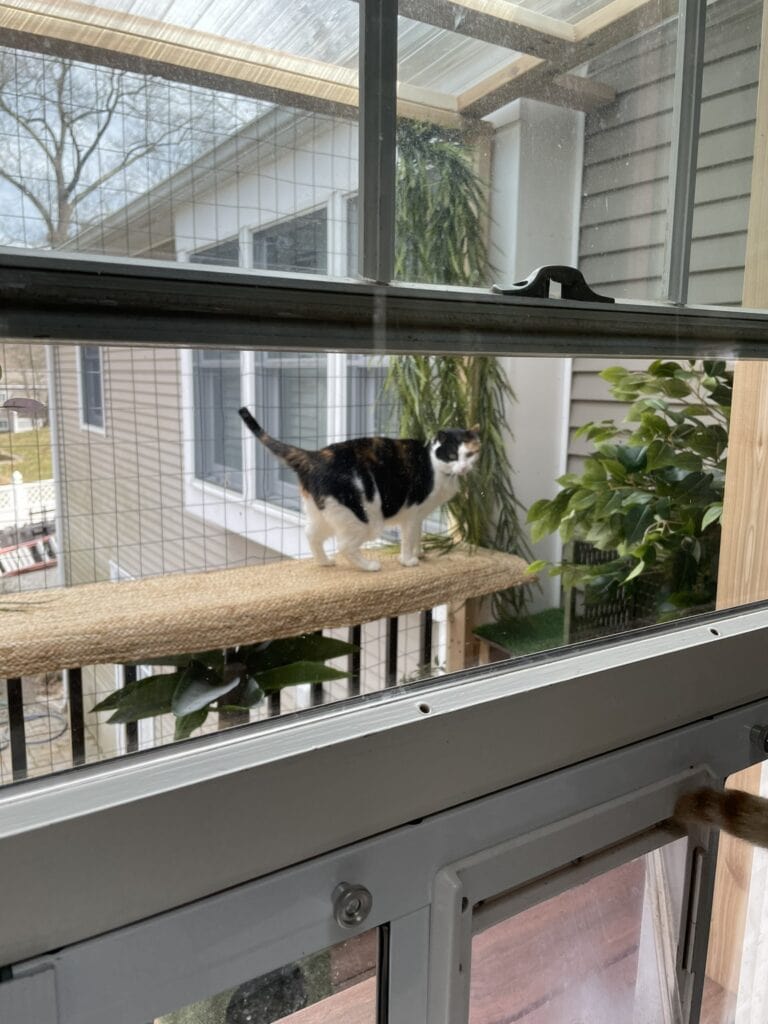

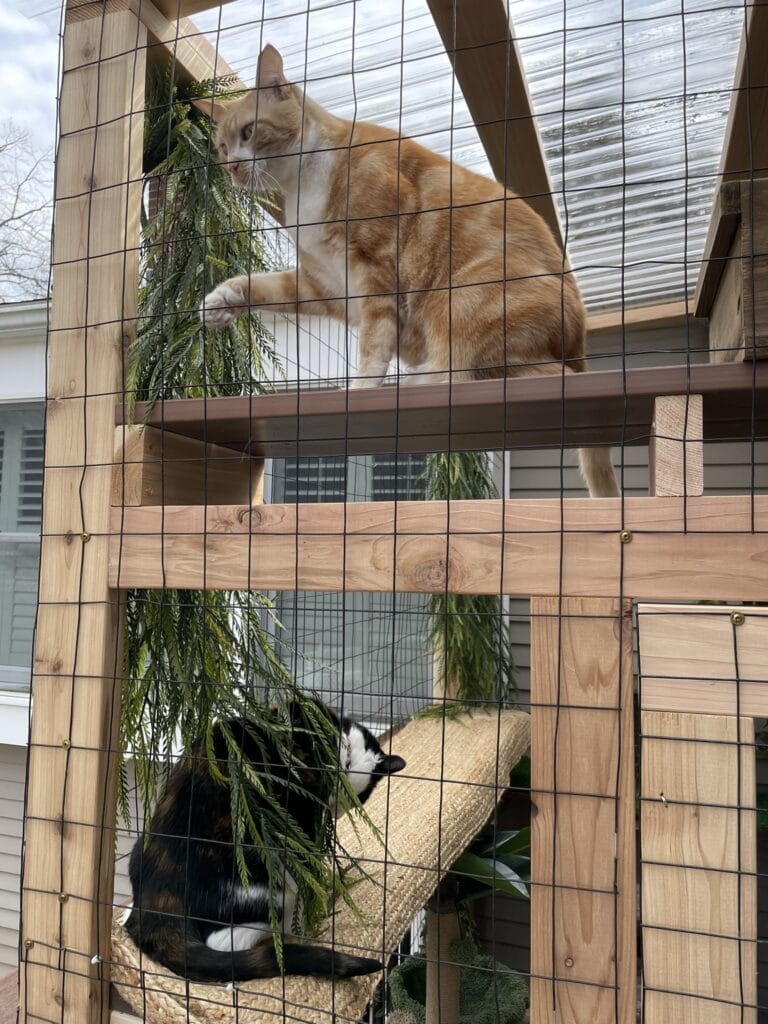
Don’t miss out on future cat-related and decorating tips! Sign up for my newsletter in the sidebar on your desktop or scroll down on mobile to receive exclusive content and updates straight to your inbox. Join our community of fellow pet lovers and decor enthusiasts today!


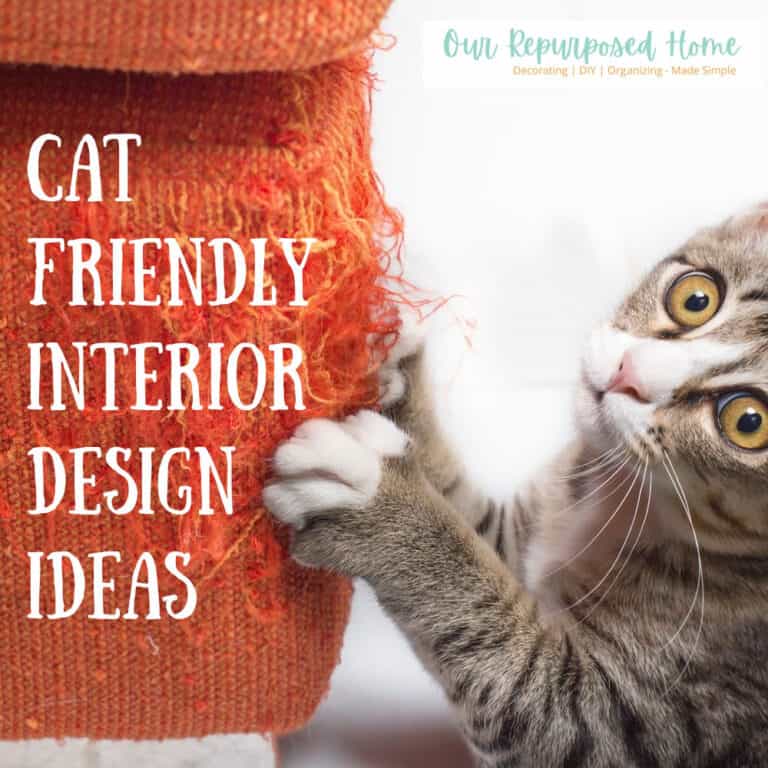
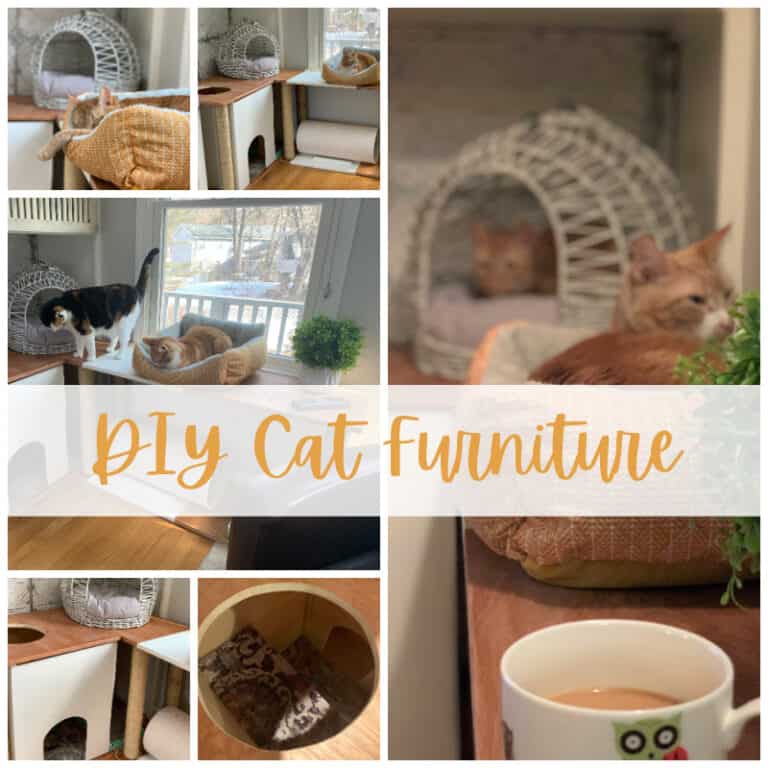

Love your ideas. Am working on building a catio from some old fence boards (Hurricane knocked down) and 2 x 4’s. Was trying to decide what to put inside so thanks.
Thank you Minnie, I hope you share your catio when your done. 🙂
What kind of plant is that hanging down inside of catio.?
Hey June, It is an artificial hanging vine from Hobby Lobby.
I absolutely love all your catio DIY ideas ! And I love how repurposed items get to live nine more lives! That’s sustainability one on one!
Thanks Emil 🙂